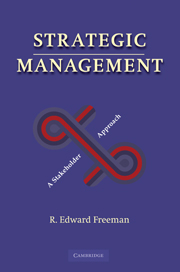Part I - THE STAKEHOLDER APPROACH
Published online by Cambridge University Press: 05 February 2015
Summary
The purpose of Part I is to explain how a recently emerging concept, “stakeholders in an organization,” can be used to enrich the way that we think about our organizations. We will discuss why U.S. managers need new concepts, tools and techniques, and new theories if they are to be successful in the current business environment.
Chapter One, “Managing in Turbulent Times,” explores recent environmental shifts, as well as the corporate responses to such shifts. Current approaches to understanding the business environment fail to take account of a wide range of groups who can affect or are affected by the corporation, its “stakeholders.” Changes have occurred which make our present framework of the firm inappropriate. We manage based on our understanding of the past, rather than the future, and in response to the business environment of yesteryear, rather than today. This chapter outlines the problem and calls for change in the way that we think about the business organization.
Chapter Two, “The Stakeholder Concept and Strategic Management,” introduces the notion that organizations have stakeholders and traces the history of this idea through several research areas of management thought, most notably corporate planning, organization theory, social responsibility, Systems theory and Strategic management. It strongly suggests that the stakeholder notion can be used to enrich the current State of the art in Strategic management, and summarizes the recent empirical research.
- Type
- Chapter
- Information
- Strategic ManagementA Stakeholder Approach, pp. 1 - 2Publisher: Cambridge University PressPrint publication year: 2010
- 70
- Cited by



